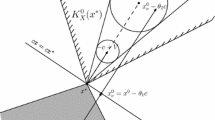Abstract
This paper mainly investigates some properties of Cheng projection, which was proposed recently by Prof. Cheng to reduce the dimension of vector. As a linear transformation from the original vector space to the target vector space, the matrix representation of Cheng projection is given. Then, the structure matrix of Cheng projection, called the Cheng projection matrix, is obtained. Algebraic properties of Cheng projection are derived via its projection matrix. Furthermore, the product and norm of Cheng projection matrices are concerned.
Similar content being viewed by others
References
Cheng D Z, From Dimension-Free Matrix Theory to Cross-Dimensional Dynamic Systems, Elsevier, London, 2019.
Feng J E, Li Y L, and Zhao J L, Four kinds of semi-tensor products and their relationships, Journal of Liaocheng University, Natural Science Edition, 2020, 33(4): 1–7 (in Chinese).
Cheng D Z, Qi H S, and Li Z Q, Analysis and Control of Boolean Networks: A Semi-tensor Product Approach, Springer, Berlin, 2011.
Li H T and Ding X Y, A control Lyapunov function approach to feedback stabilization of logical control networks, SIAM Journal on Control and Optimization, 2019, 57(2): 810–831.
Lu J Q, Zhong J, Huang C, et al., On pinning controllability of Boolean control networks, IEEE Transactions on Automatic Control, 2016, 61(6): 1658–1663.
Meng M, Lam J, Feng J E, et al., Stability and stabilization of Boolean networks with stochastic delays, IEEE Transactions on Automatic Control, 2019, 64(2): 790–796.
Liu Y, Li B W, Lu J Q, et al., Pinning control for the disturbance decoupling problem of Boolean networks, IEEE Transactions on Automatic Control, 2017, 62(12): 6595–6601.
Yu Y Y, Feng J E, Pan J F, et al., Block decoupling of Boolean control networks, IEEE Transactions on Automatic Control, 2019, 64(8): 3129–3140.
Cheng D Z, On finite potential games, Automatica, 2014, 50(7): 1793–1801.
Zhao G D, Li H T, Duan P Y, et al., Survey on applications of semi-tensor product method in networked evolutionary games, Journal of Applied Analysis and Computation, 2020, 10(1): 32–54.
Cheng D Z, On equivalence of matrices, Asian Journal of Mathematics, 2019, 23(2): 257–348.
Xu R M, Liu L F, Zhu Q R, et al., Application of a dimension-changeabel matrix model on the simulation of the population dynamics of greenhouse whitflies, ACTA Ecological Sinica, 1981, 1(2): 147–158 (in Chinese).
Pan J, Yang H, and Jiang B, Modeling and control of spacecraft formation based on impulsive switching with variable dimensions, Computer Simulation, 2014, 31(6): 124–128 (in Chinese).
Zhao P X, Guo H, Yu Y Y, et al., On dimensions of dimension-bounded linear systems, SCIENCE CHINA Information Sciences, 2021, 64(5): 159202:1–159202:3.
Feng J E, Yu Y Y, and Wang B, On dimensions of linear discrete dimension-unbounded systems, International Journal of Control, Automation and Systems, DOI: https://doi.org/10.1007/s12555-019-0147-9.
Strang G, Introduction to Linear Algebra, Wellesley-Cambridge Press, Wellesley, Massachusetts, 1993.
Cheng D Z, Qi H S, and Liu Z Q, Linear system on dimension-varying state space, Proceeding of the IEEE International Conference on Control and Automation, 2018, 112–117.
Feng J E, Zhang Q L, and Zhao J L, Cheng’s projection and its application in model reduction, Journal of Liaocheng University, Natural Science Edition, 2019, 32(1): 1–7 (in Chinese).
Horn R A and Johnson C R, Matrix Analysis, Cambridge University Press, Cambridge, 1985.
Author information
Authors and Affiliations
Corresponding author
Additional information
This paper was supported by the National Natural Science Foundation of China under Grant Nos. 61773371, 61877036, and the Natural Science Fund of Shandong Province under Grant No. ZR2019MF002.
This paper was recommended for publication by Editor SUN Jian.
Rights and permissions
About this article
Cite this article
Feng, Je., Zhang, Q. & Li, Y. On the Properties of Cheng Projection. J Syst Sci Complex 34, 1471–1486 (2021). https://doi.org/10.1007/s11424-021-9254-9
Received:
Revised:
Published:
Issue Date:
DOI: https://doi.org/10.1007/s11424-021-9254-9




